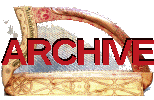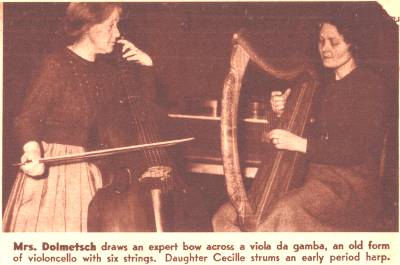

|
Dolmestch harps
Arnold Dolmetsch began making the little medieval harps in 1932; he died in 1940. On this page I will discuss people who played these instruments at that time. For later players of Dolmetsch harps see the Legacy page.
There are a number of references to the “first” of these harps being made for the Scottish harpist Heloise Russell-Fergusson in 19321. This “first clarsach” had an inscription on it. I imagine that Heloise got interested in reviving the ancient traditons, and approached Dolmetsch. However, she sold the “first clarsach” in 1945, and according to the person who acquired it then, Heloise didn’t play it, but kept it as an ornament. Heloise used a Clarke Irish harp for her professional performing career; the Clarke harp is the one she plays on all of her published recordings and also is the harp that is shown in all of the photos of her I have seen.
Mabel Dolmetsch played these harps of course.
|
“ Another instrument that caught and held attention was the clarsach, a fine example of Dolmetsch’s workmanship. It is brighter and more decisive than a harp, yet no less enchanting in its silvery tone. Almost it seems to be a deliberate echo of an early harpsichord. „ | |
Mabel also describes the harp being played at the 14th Haslemere Festival, I think in 1938:
|
“ ...the thirteenth-century Spanish cantiga, Rosa das Rosas, sung by Cécile to the accompaniment of the mediaeval harp and a small organ „ | |

Philadelphia Enquirer, 16th April, 1939
There is s photo of the Dolmetsch family, including Arnold with an archlute and Mabel with a vihuela, and a young girl with one of the harps4.
Mabel continued to play the harps after Arnold died. I have spoken to a couple who went to Jesses, the Dolmetsch house in Haslemere, for dancing practice in the 1950s, and who remember hearing Mabel playing the wire-strung harp in the kitchen as they passed by.
Arnold wrote to Heloise in July 1932 that “I have not delivered any although I have sold three”5. I would be interested to find out who else had one of Arnold Dolmetsch’s harps in the 1930s.
In the Russel-Fergusson Collection of photographs, in the Mitchell Library, Glasgow, is a portrait of Mrs B. MacArthur of Edinburgh, playing a Dolmetsch harp. This is a larger instrument, and may be one of the gut-strung ones. It is highly decorated, and Heloise’s caption says the roundels were carved in 1932 by the artist John Duncan. However, the photo is not dated6. At a meeting of the newly-formed Clarsach Society in November 1932, “Mrs B J B MacArthur, the convenor of the Edinburgh branch, brought a clarsach constructed by Dolmetsch and decorated by John Duncan RSA”7
1. Letter from Arnold Dolmetsch, July 5th 1932, to Heloise Russell-Fergusson. Glasgow Museums A.1970.6.e.[2]. Thanks to Helene Witcher for showing me this. ^
2. Basil Maine, ‘The Haslemere Festival’, The Spectator, 5 August 1932, p.10 ^
3. Mabel Dolmetsch, Personal Recollections of Arnold Dolmetsch , RKP, 1957, p154 ^
4. University of Melbourne, Grainger Collection. Online photo ^
5. Letter from Arnold Dolmetsch, July 5th 1932, to Heloise Russell-Fergusson. Glasgow Museums A.1970.6.e.[2]. Thanks to Helene Witcher for showing me this. ^
6. Russell-Fergusson collection, section F volume 1 f19r.^
7. Stuart Eydmann, In Good Hands, The Clarsach Society, Edinburgh, 2017, p.58^